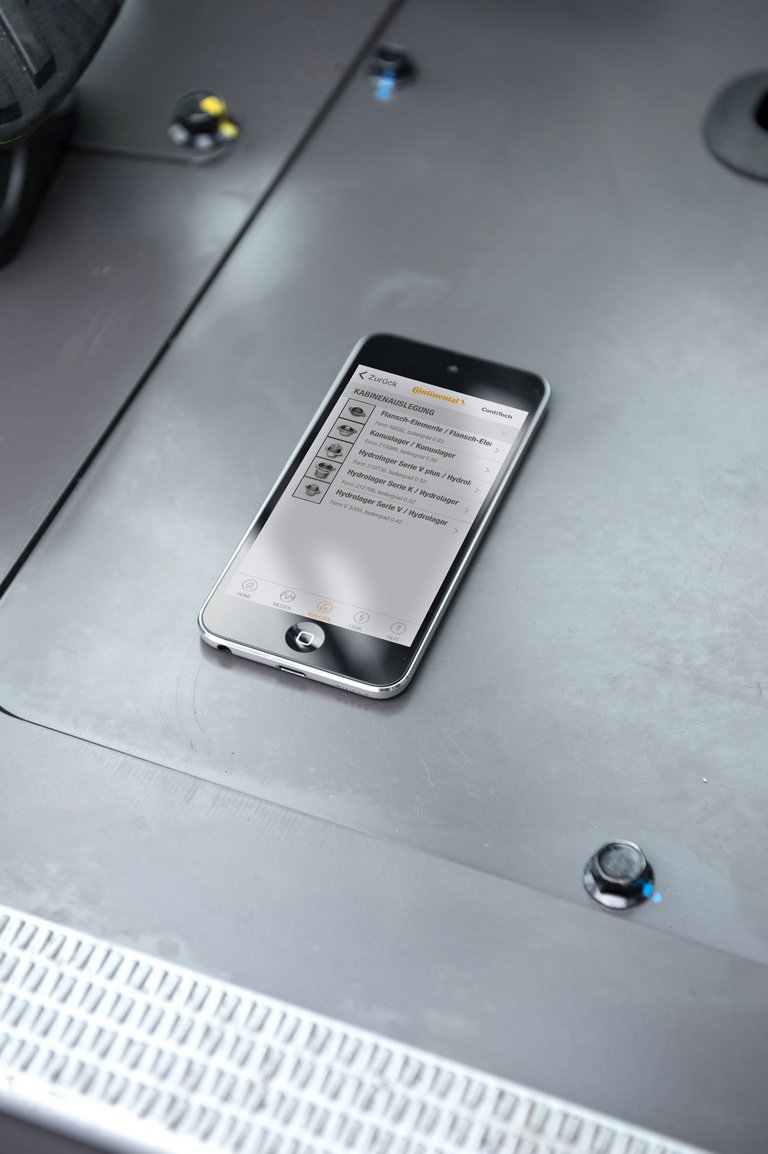Mobile Vibration Measurement by Smartphone
- ContiTech Vibration Control is offering a new mobile service. The ViProtect app enables vibration analysis using a smartphone.
Whether in driver's cabs, engines or other industrial devices, excessive vibrations put a strain on components, resulting in expensive and time-consuming downtimes and repairs. The vibrations and associated noise also cause stress for the vehicle drivers and machine operators, who are usually subjected to these disruptive factors for hours. Taking accurate measurements helps to assess the vibration behavior of industrial vehicles and machinery. The data recorded form the basis for allowing for a better system design. For example, experts can objectively rate road performance, better evaluate existing systems, and carry out simulations with real data – for both new developments and existing systems. Service life and comfort increase in the long term.
ContiTech Vibration Control has developed the ViProtect app for initial vibration measurement on site. It not only measures vibrations, but also suggests mount elements and displays their technical data. It can be installed free of charge by users in the European Union and Switzerland and runs on both iOS and Android operating systems.
Application example: measurement on an industrial vehicle
With industrial vehicles, external excitation from driving and day-to-day operations or excitation through engine vibrations cause vibrations in the machine and noise pollution. This is at the expense of the driver, who is usually exposed to vibrations and noise in the driver cab for hours at a time. However, the vehicle itself is also affected by vibrations.
In order to reduce significant vibrations and noise in the driver's cab of a mini-excavator, the operator chose a vibration test. To do this, they used the ContiTech Vibration Control app.
On opening the app, the user was given some advice on how to use it and about the possible risks of taking measurements on devices that are in operation. To improve accuracy, the app measured the calibration of the acceleration sensor. During calibration, the application determined the position of the mobile device to adapt the measurement accordingly. The user could then begin taking the actual measurement. To do this, the smartphone had to be placed on the floor of the mini-excavator's cab. After just ten seconds, the app had completed the measurement and determined the time signal. Using the fast Fourier transform (FFT) principle, the data were converted into the frequency range and visualized. The app highlighted critical excitation frequencies – one of the key factors that ViProtect requires for measurement – on the frequency spectrum and showed the numerical values. Values of 14.03 Hz, 17.45 Hz and 20.95 Hz were in the critical range. For further calculation, the vehicle operator chose 14.03 Hz, which was most similar to the idle speed of the vehicle. As an alternative, at this point, ViProtect also offers the opportunity to enter a known value manually.
The user then entered the mass of the 800 kg vehicle cab and four mounting points for the construction vehicle into the app. Afterwards, the user selected “cab” as the type of application from the menu. At this point, the menu also offers “engine stationary” and “engine mobile” as options. This is the best way to take into account operating conditions when choosing mounting elements.
Finally, using these criteria, the app indicated five suitable ContiTech mounting systems. The suggestions were arranged according to the calculated insulation; in other words, insulating effect of the respective mount. The favorite mount for the mini-excavator was a Schwingmetall flange element, which achieved a degree of insulation of 0.83. This product type is particularly suited to insulating medium-sized masses. In second place was a Schwingmetall conical spring with an insulation effect of 0.55. General advantages of this engine mount are its versatility, high radial stiffness and good lateral stability. The three Schwingmetall hydraulic springs suggested achieved good insulation values of 0.52 to 0.42. Their advantages are generally in their good insulation, which is produced via a hydraulic system inside the product.
On the basis of these data, the user was particularly interested in the Schwingmetall flange element. After choosing, the user was able to display the expected insulation effect within the frequency spectrum as a graphic. Alongside final confirmation in the system, the user received the opportunity to request more information about this product directly from ContiTech. For this purpose, the app then opened an e-mail contact form, in which the recipient address and a boilerplate for the request are provided by default.
Basis for detailed analysis
“The app offers a way to conduct an initial vibration measurement on site and for simplified design of elastic mounts,” says Dr. Stefan Narberhaus, head of industrial development at ContiTech Vibration Control. “However, the accuracy of the results is limited. The application also cannot check, for example, whether the suggested products are suitable for the respective installation space.” Therefore, ContiTech experts recommend having the app’s suggestions checked by one of the company’s application engineers.
Other processes, such as the finite element method (FEM), with which the stress scenarios are simulated in a 3D model, or multibody simulation (MKS), with which ContiTech determines the best possible mount and calculates its optimal position, offer more detailed options for the analysis. To check the effectiveness of the measurements taken, the ContiTech experts can also run a final check on the modified system.

Wolfgang Reinert
Head of Media & Public Relations
ContiTech


